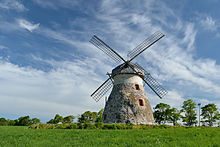Kuremaa
Coordinates: 58 ° 44 ' N , 26 ° 32' E
Kuremaa (German Jensel ) is a village ( Estonian alevik ) in the Estonian rural community Jõgeva ( Jõgeva vald ) in Jõgeva County . Kuremaa is located about 10 km from the city of Jõgeva . The village has 407 inhabitants (as of 2006).
Kuremaa Manor and Manor
Kuremaa is best known for its historical manor ( Kuremaa mõis ), which was the economic center of the place before the First World War . It was founded by the German-Swedish nobleman Johann Wrangell in the middle of the 16th century before the Livonian War .
From 1843 the estate was owned by the German Baltic noble family von Oettingen , who managed it according to the most modern knowledge of the time. The products were also sold nationwide on the Saint Petersburg market . In Kuremaa, a closed drainage system and the first milk sugar factory in the Russian Empire were built in the middle of the 19th century .
The representative manor house of today was built between 1837 and 1843 according to plans by the Tartu architect EJT Strauss. After the Estonian land reform in 1919 , an agricultural college was established there in 1934. A year later, the connecting galleries between the main building and the side wings were added another floor. A fire severely damaged the building in 1986. It was then rebuilt. In the manor house there is now a small museum on the history of the estate and the surrounding area. About two kilometers from the estate lies the von Oettingen family's small cemetery, which the landscape architect Walter von Engelhardt laid out in 1899. The chapel combines neoclassical and neo-Gothic style elements.
Kuremaa järv
The Kuremaa Manor is surrounded by a species-rich park on the northern edge of Lake Kuremaa järv . The lake has an area of 397 hectares and is up to 13.3 m deep. A nature reserve was set up in 1992 on the north and north-east bank. There is also the historic Kuremaa windmill, which was renovated a few years ago and offers a view of the lake landscape.
Web links
- Kuremaa Lake (Estonian)
Individual evidence
- ↑ http://www.jogevamv.ee/?page=498
- ↑ Indrek Rohtmets: Kultuurilooline Eestimaa. Tallinn 2004 ( ISBN 9985-3-0882-4 ), p. 212
- ↑ Ivar Sakk: Eesti mõisad. Rice yuht. Tallinn 2002 ( ISBN 9985-78-574-6 ), p. 201



